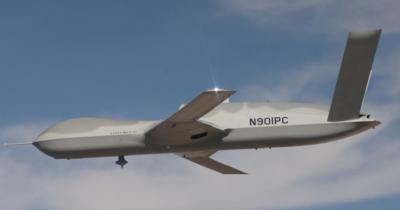Uncrewed Avenger Takes to the Skies Using AI, Machine Learning Software
General Atomics Aeronautical Systems, (GA-ASI) has completed a fully autonomous sortie using an Avenger MQ-20A equipped with their Artificial Intelligence Piloting software.

The flight used the company's Open Mission Systems (OMS) software stack and an otherwise garden variety Avenger to carry out the 30 minute voyage. The Avenger's AI pilot directed the flight while cooperating with a live (but virtual) constructive UAS swarm, stress testing General Atomics' machine learning and AI systems in a simulated battlespace.
Their software made use of novel Reinforcement Learning architecture to provide a new and innovative tool for next-generation military platforms to make real-time, rapid decisions under dynamic and uncertain conditions. The team tested the aircraft's “chase and avoid behavior”, evaluating its behavior in a contested environment where the AI had to thread its way around hostiles without any outside direction.
“The flight was a tremendous success and demonstrated a number of groundbreaking capabilities in the race to operationalize autonomy for Collaborative Combat Aircraft (CCA),” said General Atomics senior director of advanced programs Michael Atwood. “It’s exciting to see how AI can be used to advance how and where we fly unmanned systems as the complexity of the battlespace increases. Our ‘chase and avoid’ agent’s ability to dynamically update the flight path as threats were identified is the first step towards building an ecosystem of collaborative autonomous combat aircraft.”
A key component of the exercise was the TacIRST, a multifunction, embeddable sensor system with an open architecture. The system was key to the Avenger’s ability to deftly maneuver around simulated hostiles. The Lockheed Martin suite provides a range of capabilities for both crewed and uncrewed aircraft, allowing for improved detection and threat evaluation for the MQ-20.
“We anticipated the need for passive, long-range threat detection by autonomous aircraft and are proud to see this capability integrated successfully on the Avenger,” said Terry Hoehn, director of Lockheed Martin’s advanced threat warning systems. He was content in their performance, adding that the most recent sortie will be one of many more. “We look forward to further collaboration and testing General Atomics.”
The flight was fully funded in-house by General Atomics, drawing on company property to host and operate the OMS software and other General Dynamics subsidiaries for additional architecture and hardware. While digital equipment is convenient, it opens up new frontiers for systems degradation, making in-flight security vital to successful mission performance. General Dynamics Mission Systems provided the Digital Backbone Node (DBN) architecture to the project, allowing for rapid, secure deployment with mil-spec open architecture and suitable performance. The high-performance computing, cooling, and multi-level security for maximum battlefield "rapid and secure deployment of evolving capabilities". The end result is an MQ-20A Avenger with the computing power, cooling, and security needed to survive a modern battlefield while collaborating with similarly autonomous aircraft.
 ANN's Daily Aero-Linx (05.02.24)
ANN's Daily Aero-Linx (05.02.24) ANN's Daily Aero-Term (05.02.24): Touchdown Zone Lighting
ANN's Daily Aero-Term (05.02.24): Touchdown Zone Lighting Aero-News: Quote of the Day (05.02.24)
Aero-News: Quote of the Day (05.02.24) ANN FAQ: Contributing To Aero-TV
ANN FAQ: Contributing To Aero-TV NTSB Final Report: Cirrus Design Corp SR20
NTSB Final Report: Cirrus Design Corp SR20



